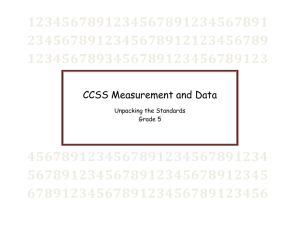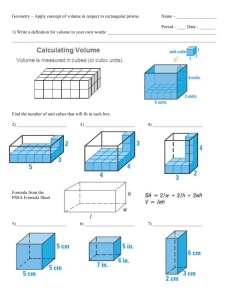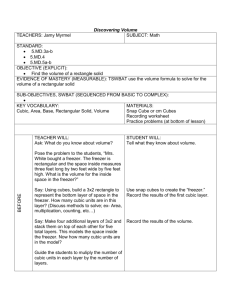Volume and Capacity
advertisement
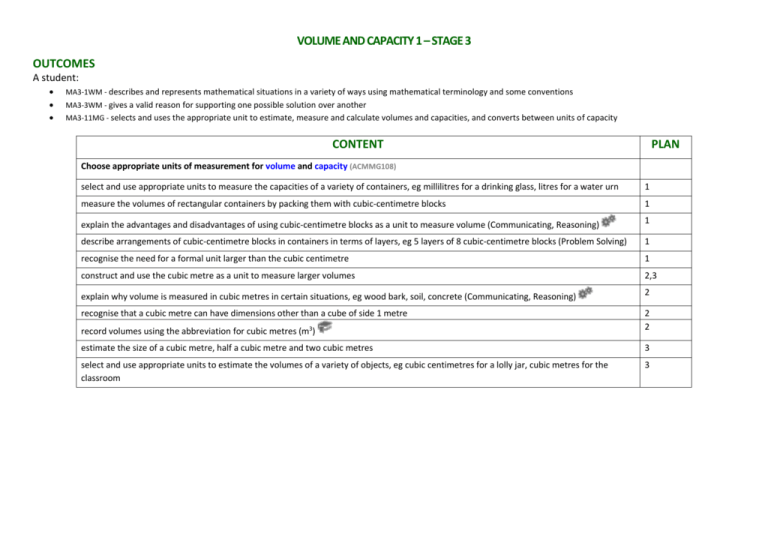
VOLUME AND CAPACITY 1 – STAGE 3 OUTCOMES A student: MA3-1WM - describes and represents mathematical situations in a variety of ways using mathematical terminology and some conventions MA3-3WM - gives a valid reason for supporting one possible solution over another MA3-11MG - selects and uses the appropriate unit to estimate, measure and calculate volumes and capacities, and converts between units of capacity CONTENT PLAN Choose appropriate units of measurement for volume and capacity (ACMMG108) select and use appropriate units to measure the capacities of a variety of containers, eg millilitres for a drinking glass, litres for a water urn 1 measure the volumes of rectangular containers by packing them with cubic-centimetre blocks 1 explain the advantages and disadvantages of using cubic-centimetre blocks as a unit to measure volume (Communicating, Reasoning) 1 describe arrangements of cubic-centimetre blocks in containers in terms of layers, eg 5 layers of 8 cubic-centimetre blocks (Problem Solving) 1 recognise the need for a formal unit larger than the cubic centimetre 1 construct and use the cubic metre as a unit to measure larger volumes 2,3 explain why volume is measured in cubic metres in certain situations, eg wood bark, soil, concrete (Communicating, Reasoning) 2 recognise that a cubic metre can have dimensions other than a cube of side 1 metre record volumes using the abbreviation for cubic metres (m3) 2 2 estimate the size of a cubic metre, half a cubic metre and two cubic metres 3 select and use appropriate units to estimate the volumes of a variety of objects, eg cubic centimetres for a lolly jar, cubic metres for the classroom 3 VOLUME AND CAPACITY 2 – STAGE 3 OUTCOMES A student: MA3-1WM - describes and represents mathematical situations in a variety of ways using mathematical terminology and some conventions MA3-2WM - selects and applies appropriate problem-solving strategies, including the use of digital technologies, in undertaking investigations MA3-3WM - gives a valid reason for supporting one possible solution over another MA3-11MG - selects and uses the appropriate unit to estimate, measure and calculate volumes and capacities, and converts between units of capacity CONTENT PLAN Connect volume and capacity and their units of measurement (ACMMG138) select the appropriate unit to measure volume and capacity 4 demonstrate that a cube of side 10 cm will displace 1 litre of water 4 demonstrate, by using a medicine cup, that a cube of side 1 cm will displace 1 mL of water 4 equate 1 cubic centimetre to 1 millilitre and 1000 cubic centimetres to 1 litre 4 find the volumes of irregular solids in cubic centimetres using a displacement strategy 4 Connect decimal representations to the metric system (ACMMG135) recognise the equivalence of whole-number and decimal representations of measurements of capacities, eg 375 mL is the same as 0.375 L 5 interpret decimal notation for volumes and capacities, eg 8.7 L is the same as 8 litres and 700 millilitres 5 record volume and capacity using decimal notation to three decimal places, eg 1.275 L 5 Convert between common metric units of capacity (ACMMG136) convert between millilitres and litres 6 explain and use the relationship between the size of a unit and the number of units needed to assist in determining whether multiplication or division is required when converting between units, eg 'Fewer litres than millilitres will be needed to 6 measure the same capacity, and so to convert from millilitres to litres, I need to divide' (Communicating, Reasoning) Calculate the volumes of rectangular prisms (ACMMG160) describe the 'length', 'width' and 'height' of a rectangular prism as the 'dimensions' of the prism 7 construct rectangular prisms using cubic-centimetre blocks and count the blocks to determine the volumes of the prisms 7 construct different rectangular prisms that have the same volume (Problem Solving) 7 explain that objects with the same volume may be different shapes (Communicating, Reasoning) 7 describe rectangular prisms in terms of layers, eg 'There are 3 layers of 8 cubic-centimetre blocks' (Communicating) 7 use repeated addition to find the volumes of rectangular prisms, eg 'My rectangle has 3 layers of 6 cubes, so the total number of cubes is 6 plus 6 plus 6, or 18' 8 establish the relationship between the number of cubes in one layer, the number of layers, and the volume of a rectangular prism 8 explain that the volume of a rectangular prism can be found by finding the number of cubes in one layer and multiplying by the number 8 of layers (Communicating, Reasoning) record, using words, the method for finding the volumes of rectangular prisms, eg 8 'Volume of rectangular prism = number of cubes in one layer × number of layers' calculate the volumes of rectangular prisms in cubic centimetres and cubic metres 8 recognise that rectangular prisms with the same volume may have different dimensions (Reasoning) 7 record calculations used to find the volumes of rectangular prisms 8

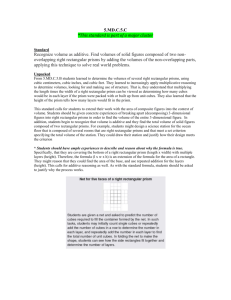
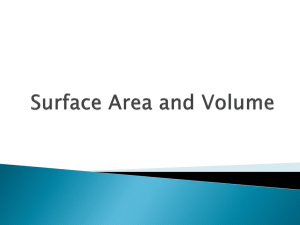
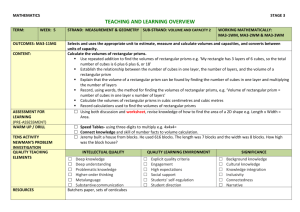
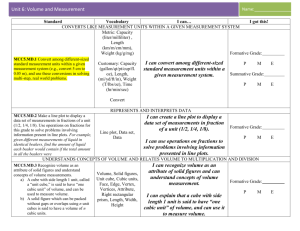
![Volume of Prisms and Cylinders [12/4/2013]](http://s2.studylib.net/store/data/005712570_1-e7691fc1893418ebe51c7a30e9e35d27-300x300.png)
